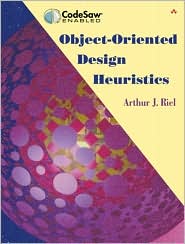
| |
From Amazon ... Upon completion of an object-oriented design, you are faced
with a troubling question: "Is it good, bad, or somewhere in between?" Seasoned
experts often answer this question by subjecting the design to a subconscious
list of guidelines based on their years of experience. Arthur J. Riel has
captured this elusive, subconscious list.
"Object-Oriented Design Heuristics"
offers insight into object-oriented design improvement. The 60 guidelines
presented are language-independent and allow you to rate the
integrity of a software design. The heuristics are not written as hard and
fast rules; they are meant to serve as warning mechanisms which allow the
flexibility of ignoring the heuristic as necessary.
|
Classes and Objects
|
1. All data should be hidden within its class.
| |

|
2. Users of a class must be dependent on its public interface, but a class
should not be dependent on its users.
3. Minimize the number of messages in the protocol of a class (protocol of a
class means the set of messages to which an instance of the class can respond).
4. Implement a minimal public interface that all classes understand.
|
5. Do not put implementation details such as common-code private functions into
the public interface of a class.
| |
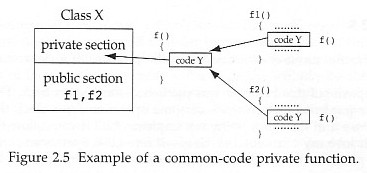
|
6. Do not clutter the public interface of a class with things that users of
that class are not able to use or are not interested in using.
7. Classes should only exhibit nil or export coupling with other classes, that
is, a class should only use operations in the public interface of another class
or have nothing to do with that class.
8. A class should capture one and only one key abstraction.
9. Keep related data and behavior in one place.
10. Spin off nonrelated information into another class (that is,
non-communicating behavior).
|
11. Be sure the abstractions that you model are classes and not simply the
roles objects play.
| |
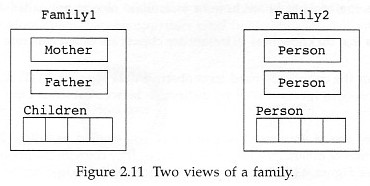
|
Topologies of Action-Oriented Versus Object-Oriented Applications
12. Distribute system intelligence horizontally as uniformly as possible, that
is the top level classes in a design should share the work uniformly.
13. Do not create god classes or god objects in your system. Be very suspicious
of a class whose name contains DRIVER, MANGER, SYSTEM, SUBSYSTEM, etc.
14. Beware of classes that have many accessor methods defined in their
interface. Having many implies that related data and behavior are not being
kept in one place.
15. Beware of classes that have too much non-communicating behavior, that is,
methods that operate on a proper subset of the data members of a class. God
classes often exhibit a great deal of non-communicating behavior.
16. In applications that consist of an object oriented model interacting with a
user interface, the model should never be dependent on the interface. The
interface should be dependent on the model.
|
17. Model the real world whenever possible. (This heuristic is often violated
for reasons of system intelligence distribution, avoidance of god classes, and
the keeping of related data and behavior in one place.)
| |
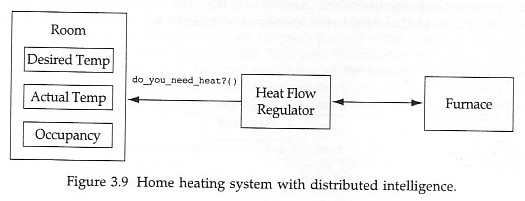
|
18. Eliminate irrelevant classes from your design.
19. Eliminate classes that are outside the system.
20. Do not turn an operation into a class. Be suspicious of any class whose
name is a verb or is derived from a verb, especially those which have only one
piece of meaningful behavior. Ask if that piece of meaningful behavior needs
to be migrated to some existing or undiscovered class.
|
21. Agent classes are often placed in the analysis model of an application.
During design time, many agents are found to be irrelevant and should be
removed.
| |
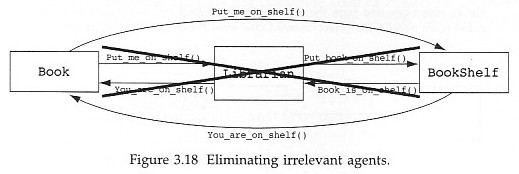
|
The Relationships Between Classes and Objects
|
22. Minimize the number of classes with which another class collaborates.
| |
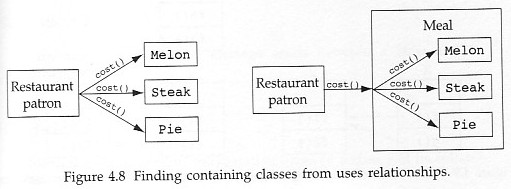
|
23. Minimize the number of message sends between a class and its collaborator.
24. Minimize the amount of collaboration between a class and its collaborator,
that is, the number of different messages sent.
25. Minimize fanout in a class, that is the product of the number of messages
defined by the class and the messages they send.
26. If a class contains objects of another class, then the containing class
should be sending messages to the contained objects, that is, the containment
relationship should always imply a <> relationship.
27. Most of the methods defined In a class should be using most of the data
members most of the time.
28. Classes should not contain more objects than a developer can fit in his or
her short-term memory. A favourite value for this number is six.
29. Distribute system intelligence vertically down narrow and deep containment
hierarchies.
30. When implementing semantic constraints, it is best to implement them in
terms of the class definition. Often this will lead to a proliferation of
classes, in which case, the constraint must be implemented in the behavior of
the class - usually but not necessarily, in the constructor.
31. When implementing semantic constraints in the constructor of a class, place
the constraint test in the constructor as far down in a containment hierarchy
as the domain allows.
32. The semantic information on which a constraint is based is best placed in a
central, third party object when that information is volatile.
33. The semantic information on which a constraint is based is best
decentralized among the classes involved in the constraint when that
information is stable.
34. A class must know what it contains, but should never know who contains it.
35. Objects that share lexical scope - those contained in the same containing
class - should not have uses relationship between them.
The Inheritance Relationship
36. Inheritance should be used only to model a specialization hierarchy.
37. Derived classes must have knowledge of their base class by definition, but
base classes should not know anything about their derived classes.
38. All data in a base class should be private; do not use protected data.
39. In theory, inheritance hierarchies should be deep - the deeper the better.
40. In practice, inheritance hierarchies should be no deeper than an average
person can keep in his or her short term memory. A popular value for this is
six.
41. All abstract classes must be base classes.
42. All base classes must be abstract classes.
43. Factor the commonality of data, behavior, and/or interface, as high as
possible in the inheritance hierarchy.
44. If two or more classes share only common data (no common behavior), then
that common data should be placed in a class that will be contained by each
sharing class.
45. If two or more classes have common data and behavior (that is, methods),
then those classes should each inherit from a common base class that captures
those data and methods.
46. Explicit case analysis on the type of an object is usually an error. The
designer should use polymorphism in most of these cases.
47. Explicit case analysis on the value of an attribute is often an error. The
class should be decomposed into an inheritance hierarchy, where each value of
the attribute is transformed into a derived class.
48. Do not model the dynamic semantics of a class through the use of an
inheritance relationship. An attempt to model dynamic semantics with a static
semantic relationship will lead to a toggling of types at run time.
49. Do not turn objects of a class into derived classes of the class. Be very
suspicious of any derived class for which there is only one instance.
50. If you think you need to create new classes at run time, take a step back
and realize that what you are trying to create are objects. Now generalize
these objects into a new class.
51. It should be illegal for a derived class to override a base class method
with a NOP method, that is, a method that does nothing.
52. Do not confuse optional containment with the need for inheritance. Modeling
optional containment with inheritance will lead to a proliferation of classes.
53. When building an inheritance hierarchy, try to construct reusable
frameworks rather than reusable components.
Multiple Inheritance
54. If you have an example of multiple inheritance in your design, assume you
have made a mistake and then prove otherwise.
55. Whenever there is inheritance in an OO design, ask yourself two questions:
(a) Am I a special type of the thing from which I am inheriting? (b) Is the
thing from which I am inheriting part of me?
56. Whenever you have found a multiple inheritance relationship in an OO
design, be sure that no base class is actually a derived class of another base
class.
The Association Relationship
57. When given a choice in an OO design between a containment relationship and
association relationship, choose the containment relationship.
Class-Specific Data and Behavior
58. Do not use global data or functions to perform bookkeeping information on
the objects of a class. Class variables or methods should be used instead.
Physical OO Design
59. OO designers should not allow physical design criteria to corrupt their
logical designs. However, physical design criteria often are used in the
decision-making process at logical design time.
60. Do not change the state of an object without going through its public interface.






